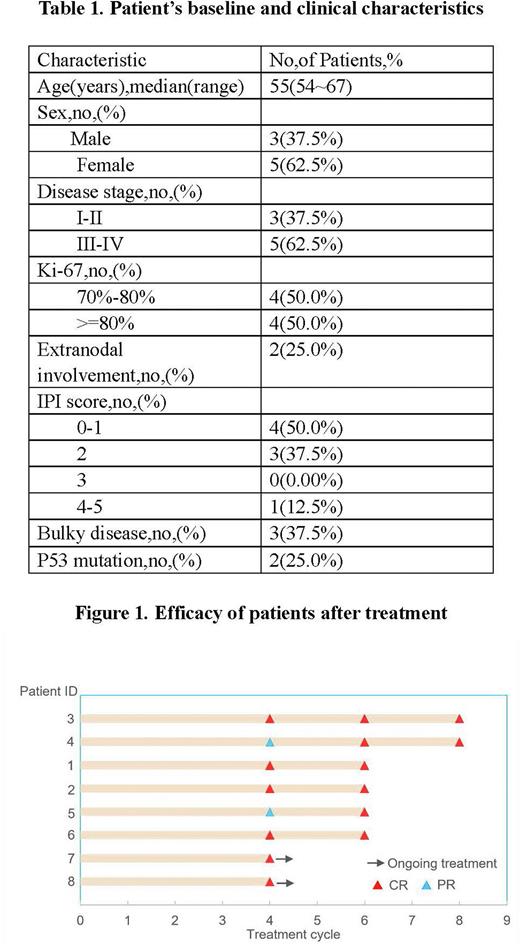Abstract
Background
Diffuse large B cell lymphoma (DLBCL), with co-expression of MYC and BCL2 proteins without rearrangements termed double-expression lymphoma (DEL), is considered an adverse prognostic indicator. The double-expression of MYC and BCL2 was positively correlated with the activation of BCR signaling pathway, which serves as a rational therapeutic target (Agata M Bogusz et al. PLoS One, 2017). Phoenix study demonstrated that ibrutinib plus R-CHOP could improve EFS and OS in younger patients with DEL (Johnson P et al. 2019 ASH ABSTRACT:354). Orelabrutinib is a novel Bruton tyrosine kinase (BTK) inhibitor with high selectivity to BTK. Preclinical study demonstrated orelabrutinib could preserve the NK-cell-mediated ADCC induced by rituximab, and the combination of these two agents produced higher anti-tumor effects than each alone in vivo or in vitro (Hui Yu et al. Molecular Therapy, 2021) . This study aimed to evaluate the efficacy and safety of O-RCHOP regimen in treatment- naïve patients with DEL DLBCL.
Methods
This was a prospective, single-arm, phase Ⅱ study recruiting treatment-naïve patients with DEL DLBCL. DEL was defined as ≥40% positive rate for MYC and ≥50% for BCL2 by immunohistochemistry (IHC). The double hit cases were excluded. All patients were treated for 6-8 cycles with 21 days per cycle. They received 150mg of orelabrutinib once daily on day 1-14 combined with RCHOP (Rituximab 375mg/m2, cyclophosphamide 750mg/m2, liposome doxorubicin 30mg/m2, vincristine 1.4mg on day 1 & prednisone 100mg/d x 5). The primary endpoint was EFS. Response was assessed after 4 or 6 cycles using PET-CT. adverse events (AEs) were assessed according to the Common Terminology Criteria for Adverse Events (CTCAE) v 5.0.
Results
From March 27, 2021 to July 26, 2022, 8 patients with DEL were enrolled. All patients received O-RCHOP regimen and underwent at least one treatment response evaluation. The baseline characteristics of the patients were listed in Table 1. All the 8 patients achieved CR (100.0%) (Figure 1). After a median follow-up of 8.42 months (2.73-12.83 months), the estimated 12-months EFS rate was 100.0%. None of the 8 patients experienced disease progression or death at the cutoff date. Two of 8 patients had the mutation of TP53 with or without other cytogenetic abnormalities tested by NGS.
Grade 3/4 AEs were mainly hematological toxicity including febrile neutropenia (12.5%), neutropenia (62.5%), anemia (34%), and thrombocytopenia (25.0%), which were manageable. The incidence of all-cause infection was 12.5% (1/8). No atrial fibrillation, tumor lysis syndrome or hemorrhage were reported. No patients discontinued treatment due to toxicity.
Conclusion
The combination of orelabrutinib and RCHOP showed encouraging efficacy and a tolerable safety profile in DEL DLBCL in this preliminary analysis. More data will be updated from this ongoing study.
Keyword(s): DLBCL, double expression,Orelabrutinib
Disclosures
No relevant conflicts of interest to declare.
Author notes
Asterisk with author names denotes non-ASH members.


This feature is available to Subscribers Only
Sign In or Create an Account Close Modal